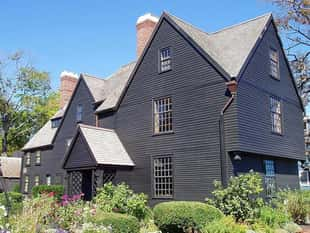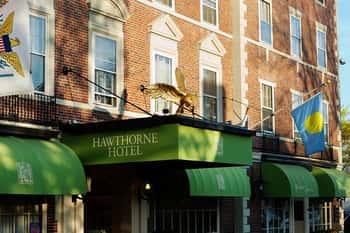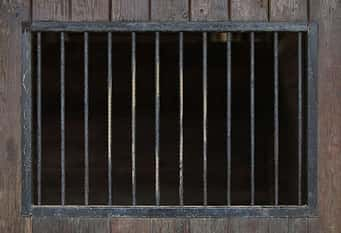In Salem, Massachusetts, there is only one house spoken of in hushed whispers and eyed with nervous glances: the Joshua Ward House.
Lucky for most, the 19th-century Federal-style mansion at 148 Washington Street is off-limits to the general public, as it is currently home to the Higginson Book Company and Carlson Realty. Its alarmingly spooky hauntings are therefore relegated to only the employees and the rare paranormal investigator allowed inside.
But for those who have had firsthand experience of stepping inside the Joshua Ward House, they almost always leave with the most unsettling of paranormal encounters. A rogue candle flying off the shelves, the aching, ghostly cries of a child, and, of course, the startling sensation of invisible hands circling your neck and . . . tightening.
The Joshua Ward House is not for the faint of heart, so it’s probably a good thing that tourists and other random passersby must stand out on the sidewalk. No matter how brave you are, no one is brave enough to encounter “the Strangler,” and a visit inside the Joshua Ward House may just deliver you that supernatural chance.
Don’t say that we didn’t warn you.
The Joshua Ward House has quite an illustrious history. Built for the wealthy sea merchant Joshua Ward in 1784, the two-story, brick Federal-style once had a grand view of the South River. As ships passed through on their way to Boston, the property’s full frontage view of the river reached its climax in 1830 when the Front Street waterway was filled in.
Despite the then less than ideal scenery, Joshua Ward’s house remained one of the most historically significant since its initial construction. Even President George Washington paid a visit when he traveled to Salem in 1789!
According to a 1979 article from the Salem Evening News, “The Joshua Ward House, on Washington Street opposite Front Street, was once symbolic of Salem’s early prosperity. When George Washington visited the city in 1789, he asked to stay at the house, then only a few years old.” (Or, perhaps he asked to stay because he liked the thought of a Washington staying on Washington Street. Perhaps not, though).
Regardless, Washington’s second floor guest room (much) later held a white marble bust of his person. People walking down on the street often paused mid-step when they glanced up at the home and spotted none other than a spirit peering out the window! Not a ghost, of course--just a good ol’ George Washington statue positioned near a window.
This would not be the first, nor the last, glimpse of a “spirit” at the Joshua Ward House was spotted.
The Joshua Ward House’s origins may have started in 1784, but the property’s history dates back to the 17th-century and Salem’s infamous witch trials. The original building to sit at 148 Washington Street belonged to George Corwin, whose ghastly reputation has preceded him for four centuries.
At the age of twenty-five, on May 27, 1692, George Corwin was elected to the position of High Sheriff in Essex County. Corwin was well-connected in Colonial Massachusetts; his uncles were the Justices Corwin and Winthrop, and he was also the son-in-law of Justice Gredney.
By the time Corwin stepped into the position, the Salem witch hysteria had already erupted. Women like Rebecca Nurse and Sarah Good, among others, were charged with casting evil magic on the afflicted. And powerful men like George Corwin were all too willing to assign the blame . . . and to assign subsequent torture.
Not three months after Corwin stepped into office as High Sheriff, he was tasked with transporting five of the most infamous “witches.” On July 19, 1692, Rebecca Nurse, Susanna Martin, Elizabeth How, Sarah Good and Sarah Wildes were removed from the jail and shoved into wooden carts.
Amidst an early morning fog, townspeople lined the streets to watch the cart rumble down the dirt roads to the lake for the executions. At the time, it was apparently tradition for the accused to attempt facing death in order to both confess their sins or prove their innocence. Ironically, however, the method to proving one’s innocence generally meant death. (Nothing like giving it all up to God, wouldn’t you say?)
As the High Sheriff, George Corwin had fulfilled his duty in bringing the women to the gallows. From there, it was Reverend Nicholas Noyes’ responsibility to coerce the accused into admitting their guilt. Noyes demanded one of the accused witches, Sarah Good, to confess her sins. She refused, snapping, “You are a liar. I am no more witch than you are a wizard, and if you take away my life God will give you blood to drink.” With those words, Sarah Good sealed her fate. Corwin positioned them all above the lake, linking the nooses around their respective necks. Then, he hanged them all, their bodies plunging into the water.
(Fun Fact: Sarah Good’s final words would later come to haunt the townspeople of Salem, when Reverend Noyes died bleeding at the mouth. A blood vessel had popped, but superstitious believers believed that he’d been cursed by a witch).
Following the executions, the bodies were buried nearby in the rocky terrain. Under the cover of darkness, Rebecca Nurse’s family took a small boat (perhaps a canoe) up the river so that they could retrieve Rebecca’s body. According to the historian Marilynne K. Roach, “from there a small craft could slip downstream past town on the midnight’s high tide, then north up the estuary to Crane River and along its narrowing length to the Nurses’ land, where they buried her privately on homeground.”
For now, the witches and sorcery had been put to bed--but the fear of the Devil persisted and led to more deaths, especially those hand-delivered by George Corwin.
Modern-day rumors swirl around George Corwin. He’s been labeled a sadistic murderer who thrived on grim, gritty torture. In fact, during so-called “reign of terror” (Robespierre and the French Revolution, anyone?) Corwin took a fancy to a certain type of cruel killing.
Allegedly, his favorite method of dragging confessions out of the accused was to tie them from their neck to their ankles, bending them in half, until blood streamed from their nose.
For poor Giles Corey, one of the only “warlocks” to be accused during the witch trial hysteria, his punishment stretched to new limits.
On an eerie morning of September 18, 1692, Giles Corey’s execution was scheduled to follow the accused witch’s Ann Putnam, Jr. Ann was one lucky witch, however, for on that day she escaped the death that the vengeful witnesses were so desperate to watch.
Corey was not so lucky. In the months leading up to his trial, there had been innumerable claims of Giles Corey being a warlock. In June 1692, Elizabeth Woodwell and Mary Walcott (two of the afflicted) had watched in shock as Giles Corey entered the Salem Meeting House, despite the fact that he’d already been imprisoned. In another instance, a ghost had risen from the dead to tell Ann Putnam, Jr. that Corey had been the spirit’s murderer.
Two weeks before the official trial, the court had attempted to push Corey to answer the formality which started the trial. Without saying the words, “By God and my country,” no trial could occur. Corey refused, “standing mute,” as the term applied.
The punishment for this crime under English law meant that Corey was punishable by peine forte et dure (pressing under heavy weights) until the words were finally said. After months of back and forth, including Corey’s good friend Captain Thomas Gardner pleading with him to just confess, September 19 was the final day. Corey refused to confess to the crime, nor would he say the necessary words for an actual trial to continue, and so George Corwin adhered to the law, however cruel it was.
Corwin put Giles Corey into the dirt, leveling a flat wooden board on top of his splayed body. Then, the true torture began. One by one large stones were placed on top of Corey, as a group of onlookers gathered ‘round to watch the proceedings in an open pasture not far from the prison. While the hope was for Corey to plead guilty early on, he never did so.
In fact, it’s said that Giles Corey spoke only once throughout the entire ordeal. “More weight!” he ordered, as his body imprinted into the dirt.
Allegedly, as Corey’s tongue began to loll from his mouth (a sign that death was upon him), George Corwin unsympathetically used the tip of his walking stick to push Corey’s tongue back into his mouth. Corey died not long after that, his body so brutally crushed that there was no hope for his revival--his death was the only pressing to ever occur in Massachusetts, but it is one image that we have never been able to forget.
Corey’s body was buried by Butt’s Brook, the burial place of suicides in Salem Town, as though he had chosen to take his own life. And George Corwin, the High Sheriff whom everyone despised, visited Corey’s home and took all of the man’s money and goods as his own.
Centuries later, George Corwin is still remembered as the most hated man of the Salem Witch Trials, and so it’s not much of a surprise that his spirit may still be haunting the land in which he once lived.
For a time in the late 19th century, the Joshua Ward House was converted into a fancy hotel by the name of The Washington Hotel. (The Washington Hotel on Washington Street, where Washington once visited...very appropriate, don’t you think?) But, by the mid-20th century, the hotel's popularity started its decline and the property was abandoned. Planning began in the 1970s to construct a commercial building on the former hotel’s sweeping front lawn, until preservation societies stepped in and put a stop to that.
Thankfully, the very real possibility of the Joshua Ward House being demolished didn’t happen and it thereafter converted into a multi-unit property with different offices.
And then, rumors of ghosts and hauntings began.
Ask a local tour guide which house they think is the most haunted and nine out of ten times they’ll lead you straight to 148 Washington Street. For decades now, the Joshua Ward House has sat, a beautiful example of 18th century architecture with a less than ideal past. A past that isn’t content to remain a slice of history. For employees of either Carlson Realty or the Higginson Book Company, an average workday consists of more than calendars, tasks and office gossip.
The Salem Pioneer once reported: “Another sighting, that of the sheriff himself, was said to have been witnessed by another former book publisher.”
It’s said that three spirits linger at the Joshua Ward House, two of which are not the friendliest of paranormal entities.
Considering that this land once belonged to High Sheriff George Corwin, it should be no surprise that his ghost is said to still haunt the building. Especially when you factor in that he was buried on the land.
On April 12, 1696, at just thirty years of age, the “monster” George Corwin slipped and fell in the snow while at home. Medicine suggests that he’d suffered a heart attack, but what occurred next is cause for many rumors that still persist today among tour companies and amateur historians.
Despite having a hand in the trials of all nineteen deaths of the Salem witch trials, and over 150 arrests during the same period, one in particular stuck out the most: Mary English. Her relation, Philip English, was not so enamored with the fact that Corwin, in his customary way, went to the English household and confiscated all the goods to be found there. Corwin took and took, but a year or so later Philip English enacted his revenge by suing George Corwin for what had been stolen from him.
But Corwin had lost everything by then, and was imprisoned because he could not pay bond.
Listen to local lore and you’ll hear a variation of this tale, of Corwin’s family burying his body in the basement. They feared Philip English would strike another revenge by stealing Corwin’s body.
Other rumors include one that had Philip English throwing Corwin’s dead body over his horse’s saddle and riding away from Salem Town.
The truth is less exciting. Corwin’s family interred his body in the family tomb on the land and not in the cellar.
It seems, however, that Corwin’s spirit has never left his land.
There have been multiple accounts of people experiencing a choking sensation on the second floor of the property. On one such occasion, a visitor was upstairs when all of a sudden he felt an invisible force encircle his throat and squeeze. Air became harder to take in, and he later swore in Robert Cahill’s book, Ghostly Haunts, that his throat had closed up completely.
When he twisted around to see who was there, he found an empty hallway. He was completely alone.
Many believe that Corwin hauled his victims out of the Witch Dungeon in order to privately “interrogate” (i.e. strangle) them in his home, now the Joshua Ward House. There is no evidence suggesting that Corwin did this, but visitors to the property remain wary anyway. And rightfully so, since the mere idea of being choked by a poltergeist is literally the stuff out of nightmares.
Just as George Corwin’s ghost haunts the Joshua Ward House, so does his victim, Giles Corey. On more than one occasion employees have witnessed inexplicable activity that they attribute to the warlock’s vengeful spirit.
Activity such as books being yanked from the shelves, cold spots in an otherwise warm room and candles found in a pool of wax, though the candles was never set aflame, are all said to be signs that Corey’s ghost has not yet crossed over to the Other Side.
Most peculiar is the fact that these candles are often melted into S shapes . . . perhaps in honor of “High Sheriff Corwin?” While the answers continue to elude the living, there is no secret that the final ghost said to still haunt the Joshua Ward House has a strong dislike toward men. And she does not hide from making this dislike known.
Sightings of a female spirit are common occurrences at the Joshua Ward house, especially on the upper floor. It was one stray piece of paranormal evidence that catapulted this rogue ghost to international stardom, though. In the 1980s, Carlson Realty was hosting a massive holiday party when one of the employees snapped a quick Polaroid photo. Shaking it, Carlson expected to see the image of a light-haired woman enjoying the party.
What he saw when he glanced down was something entirely different: a dark-haired woman with rough-hewn features and skin that was so pale and translucent he had to take another look.
When Robert Cahill published his book, Ghostly Haunts, he incorporated the photo of the ghostly figure and it caught the notice of major TV news stations across the counter. Various reports of seeing this dark-haired figure lounging on the second floor had since come out, and most assume the female spirit to be one of the witches George Corwin arrested and imprisoned . . . and possibly even killed.
If this is true, then it’s no wonder that men who visit the Joshua Ward House bear the brunt of the poltergeist activity. On several instances, they have left with scratches etched into their chests and the uncomfortable sensation that they are being watched. Is it possible that the choking phenomena is not George Corwin’s doing, but actually that of a “witch” he resigned to death with a biased trial?
At the Joshua Ward House, all seems possible . . . including the impossible.
From accused witches to torturous sheriffs, the Joshua Ward House is not a place for the weak of heart. While off limits to the general public, this shouldn’t stop you from taking a stroll past its front lawn.
When you glance up, will you see George Washington’s bust peering down at you? Or perhaps the face of a true ghost, the High Sheriff Corwin who took pleasure in eradicating witches and warlocks from Salem Town over four hundred years ago?
While the Joshua Ward House may very well be the most haunted building in Salem, do be aware that on certain ghost tours the tales of misdeeds at this location are often more founded in rumor and legend.
And at this haunted house, the truth is way more unsettling than the fiction ever could be.

One of Salem's most famous haunted houses

Spend a night in Salem's most haunted hotel

One of Salem's most haunted places